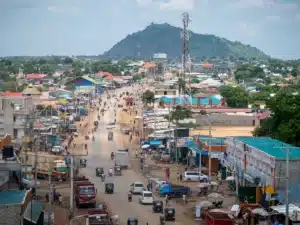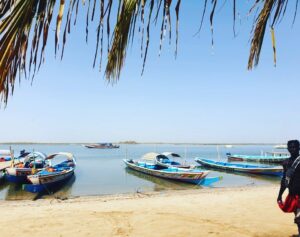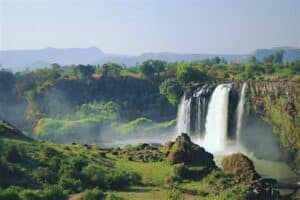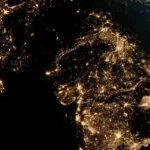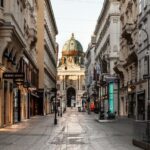Knowing which countries have the fastest-growing economies in helping you make informed investment decisions as well as help determine future planning if you’re looking to relocate. Rapidly growing economies often present opportunities for trade, investment, and development assistance.
The article below gives an overview of the top 10 fastest-growing economies globally based on GDP growth. It also includes reasons for their rapid and continuous growth and, potential future plans that will further influence their economic expansion.
Top 10 Fastest-Growing Economies in the World
For the purpose of this article, we have consulted research from the International Monetary Fund (IMF) to get an overview of the 10 fastest-growing economies currently. Please note that the data below focuses only on the GDP growth rate.
Projections by the IMF have highlighted the potential for significant growth in several African nations, driven by factors such as oil production, post-conflict reconstruction, and infrastructure development.
India and Bangladesh also show continued robust growth, reflecting the result of strong domestic demand and economic reforms.
1. South Sudan
Projected GDP growth rate: 27.2%
South Sudan’s projected GDP growth is the highest globally and it is primarily driven by the recent recovery of its oil sector.
This surge follows a significant economic contraction in 2024 due to disruptions in oil production caused by conflict-related pipeline damage in neighboring Sudan.
Aside from a resumption of oil exports, the following factors are also contributing to this African country’s rapid economic growth:
- Economic Rebound from Previous Contraction: The anticipated growth represents a rebound from a 24.5% GDP contraction in 2024, making the high growth rate partly a statistical recovery from a low base.
- Infrastructure Development: Efforts to improve infrastructure, such as the planned Karuma–Juba High Voltage Power Line and the Juba Solar Power Station, aim to enhance energy access and support economic activities.
- International Partnerships: South Sudan is engaging in international collaborations to bolster its economy, including discussions with Russian entities for developing oil refineries and securing oil-backed loans from the UAE for infrastructure projects.
2. Guyana
Projected GDP growth rate: 14.4%
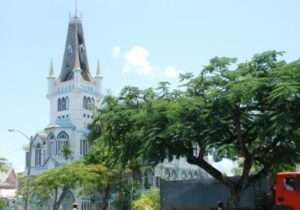
Its natural landscapes is a main feature, boasting lush rainforests, majestic waterfalls, and rich biodiversity. Guyana offers abundant opportunities for eco-tourism and exploration.
The country’s vast economic growth is being driven by:
-
Oil Production Boom: Significant offshore oil reserves were discovered in 2015 and since then Guyana has seen a substantial increase in oil production. By 2024, production reached approximately 616,000 barrels per day, positioning Guyana as Latin America’s fifth-largest crude exporter. The oil sector expanded by 57.7% in 2024, contributing significantly to the country’s GDP growth.
-
Non-Oil Sector Expansion: Aside from oil, Guyana’s non-oil sectors have also experienced growth. In 2024, the non-oil economy grew by 13.1% due to agriculture, services, and construction industry development. Continued growth of 13% in 2025 is expected.
-
Economic Diversification Efforts: The Guyanese government has realized the risks of being too over-reliant on oil and started investing in diversifying its economy. Some initiatives have included the development of agriculture through modern techniques like hydroponics and investment in infrastructure projects such as highways and energy facilities.
-
Foreign Investment and Infrastructure Development: The oil boom has attracted significant foreign investment. Notably, Chinese companies are investing in various infrastructure projects, including hospitals, roads, and bridges, to further stimulate the economy.
3. Libya
Projected GDP growth rate: 13.7%
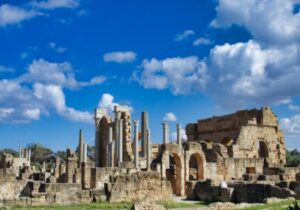
Despite its archaeological treasures, the country has faced political instability and conflict in the past, which has impacted its socio-economic development and regional dynamics.
However, despite these challenges, the country’s economy is recovering and expanding quickly with the help of:
- Oil Production Recovery and Expansion: As with other African country’s on this list, Libya’s economy is heavily reliant on oil. It accounts for approximately 60% of its GDP and 95% of export revenues. After years of conflict-induced disruptions, oil production has rebounded to about 1.4 million barrels per day, nearing pre-civil war levels.
- Attracting Foreign Investment: In 2025, Libya launched its first oil exploration bidding round in over 17 years, offering 22 areas for development under more investor-friendly Production Sharing Agreements (PSAs). This move has garnered huge interest from international oil companies, signaling renewed confidence in Libya’s energy sector.
- International Partnerships: Italy’s energy company Eni plans to invest over €8 billion in Libya over the next four years, aiming to boost energy production to meet rising domestic demand and supply Europe. Such investments are part of broader efforts to strengthen economic and political ties between Libya and European nations.
- Economic Diversification Initiatives: Libya’s government has initiated a 2025 economic diversification strategy to offset the potential risks of over-reliance on oil. This plan focuses on strengthening non-oil sectors, empowering the private sector, increasing exports, and building a more resilient economy.
4. Senegal
Projected GDP growth rate: 9.3%
Many efforts are being combined that are helping to drive significant economic growth, positioning Senegal as a dynamic and resilient economy in the region:
- Emergence as an Oil and Gas Producer: In 2024, Senegal commenced production at its first offshore oil project, the Sangomar field, operated by Woodside Energy, with a target of 100,000 barrels per day. Additionally, the Greater Tortue Ahmeyim (GTA) liquefied natural gas (LNG) project began operations at the end of 2024, with the aim of producing approximately 2.5 million tons of LNG annually.
- Long-Term Development Plan: Senegal has unveiled a 25-year development strategy focusing on economic sovereignty, competitiveness, and sustainable resource management. The plan aims to reduce the budget deficit to 3% of GDP by 2029 and increase electricity access to 100% from the current 84%.
- Investment in Infrastructure and Energy: Significant investments are underway to bolster Senegal’s infrastructure and energy sectors. The Sambangalou Hydroelectric Power Station, expected to be commissioned in 2025, will add 128 MW to the national grid, enhancing electricity supply and supporting regional integration.
- Economic Diversification and Reforms: Efforts to diversify the economy include investments in agriculture, services, and manufacturing sectors. The government is also implementing reforms to improve governance and transparency, particularly in the management of natural resources.
These combined efforts are expected to drive significant economic growth, positioning Senegal as a dynamic and resilient economy in the region.
It also helps that Senegal, of all the countries on this list, is one of the easiest countries to get citizenship in due to its short timeline, inclusive policy and welcoming atmosphere to investors.
5. Palau
Projected GDP growth rate: 8.5%

This island country is renowned for its stunning natural beauty, vibrant marine life, and unique cultural heritage, making it a popular destination for diving, snorkeling, and exploring.
Aside from the stunning island vibes, the Jellyfish Lake is one of its most well-known attractions. Visitors flock there to swim with millions of non-stinging jellyfish.
The following factors are key drivers of this island’s fast-growing economy:
- Tourism Recovery: Tourism accounts for about 40% of Palau’s GDP and it is experiencing a strong rebound after a slump due to the COVID-19 pandemic. In 2024, international arrivals reached 58.9% of pre-pandemic levels, with notable increases from markets such as Taiwan, North America, and new direct flights from Australia and Japan. This resurgence is expected to continue and is bolstered by upcoming events like the Pacific Mini Games 2025 and the opening of new hotels.
- Infrastructure and Construction Projects: Significant investments in infrastructure are contributing to economic growth. These include projects funded by the renewed Compact of Free Association (COFA) with the United States, grants from Taiwan, and initiatives like the U.S.-funded Mobile Network Modernization project. Private sector investments, particularly in the hospitality industry, are also playing a crucial role.
- Fiscal Support and Reforms: The COFA agreement with the United States has been renewed and is set to provide the country with $890 million over 20 years, which supports Palau’s fiscal stability. Additionally, tax reforms, including the introduction of the Palau Goods and Services Tax (PGST), have improved revenue collection, aiding in fiscal consolidation and debt management.
- Strategic Economic Diversification: Recognizing the need to diversify its economy, Palau’s government has been exploring sustainable fishing practices. It is also considering adjustments to its marine sanctuary policies to balance conservation with economic needs. These efforts aim to reduce the reliance on tourism and create a more resilient economic structure.
6. Niger
Projected GDP growth rate: 7.8%
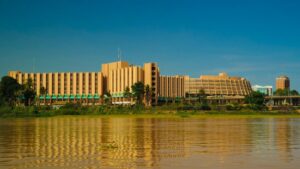
The country is characterized by a predominantly desert terrain, particularly in the north, with a hot and dry subtropical climate.
Major geographical features include the Aïr Mountains in the north-central region and the Lake Chad basin in the southeast.
The combined following elements are why Niger is projected to grow so quickly:
- Continued Focus on Agriculture: This industry has always been a cornerstone of Niger’s economy. Efforts to improve agricultural productivity and resilience are ongoing, aiming to ensure food security and provide employment for a significant portion of the population.
- International Partnerships and Investment: Niger is strengthening international partnerships to support its economic development. For instance, a memorandum of understanding worth $400 million was signed with China National Petroleum Corporation (CNPC) for the sale of crude oil from the Agadem oilfield. Additionally, cooperation agreements with countries like Turkey aim to enhance collaboration in energy, mining, and defense sectors.
- Expansion of the Oil Sector: Niger’s economic growth is significantly bolstered by the expansion of its oil industry. The completion of the Niger–Benin Oil Pipeline enables the country to export crude oil from the Agadem oilfield to international markets via the port of Cotonou in Benin. This development is expected to increase oil production to approximately 110,000 barrels per day, with around 90,000 barrels allocated for export.
- Infrastructure Development: Major infrastructure projects are contributing to economic growth. The Kandadji Dam, a multipurpose dam on the Niger River, will generate 130 MW of hydroelectric power and support irrigation for agriculture, enhancing food security and energy supply. |The Savannah Tarka Wind Power Station is a 250 MW wind farm expected to be commissioned in 2025 and is Niger’s first large-scale wind power project, diversifying the country’s energy sources and promoting renewable energy.
The country addressing political and security challenges is one of the main keys, alongside the above, to maintain its growth trajectory.
7. Rwanda
Projected GDP growth rate: 7.5%

It is characterized by mountains in the west, savanna in the southeast, and numerous lakes throughout the country.
The main factors contributing to this growing country is:
- Services Sector Augmentation: The services industry remains the primary contributor to Rwanda’s GDP, accounting for 47% in the second quarter of 2024. Growth in this sector is bolstered by strong performances in trade, transport, financial services, information and communication, and tourism.
- Industrial Development: The industrial sector contributed 21% to GDP in the same period, driven by manufacturing, construction, and mining activities.
- Agricultural Strength: Agriculture remains vital (especially in tea production), contributing 25% to GDP and employing about 70% of the population. Efforts to improve agricultural productivity and resilience are ongoing, aiming to ensure food security and provide employment.
- Strategic Economic Planning: Rwanda’s Vision 2050 outlines goals to transform the country into an upper-middle-income nation by 2035 and a high-income nation by 2050. This vision focuses on human capital development, export dynamism, urbanization, competitive enterprises, agricultural modernization, and strong public institutions.
- Innovation and Technology Hubs: Initiatives like Kigali Innovation City aim to position Rwanda as a regional technology hub, attracting universities, tech companies, and startups.
8. India
Projected GDP growth rate: 6.5%
- Strong Domestic Demand: With a population exceeding 1.4 billion, India has a vast and growing middle class that is fueling consumption. Rapid urban migration is helping to support housing, retail and infrastructure sectors. Income levels are improving in rural, tier 2 and tier 3 cities. This, in turn, is boosting spending.
- Demographic Dividend: The young workforce (over 65% of the population is under the age of 35) offers a vast labor pool and potential for high productivity. Government schemes like Skill India are helping to enhance employability and workforce capabilities.
- Robust Services and Technology Sectors: India is a global leader in software exports and business process outsourcing (BPO). The country also hosts one of the world’s largest startup ecosystems, particularly in fintech, edtech, and health tech.
- Manufacturing and Infrastructure Push: The “Make in India” initiative is promoting domestic manufacturing and attracting foreign investment. The government is also providing production-linked incentives which are targeted subsidies and incentives for key sectors like electronics, pharmaceuticals, and green energy. Programs like the Gati Shakti National Master Plan is providing a massive boost to infrastructure.
- Policy Reforms and Governance: The introduction of the Goods and Services Tax (GST) has simplified the indirect tax system and improved compliance. India’s use of digital identity (Aadhaar), UPI payments, and e-government services has improved efficiency and financial inclusion while regulatory reforms have enhanced India’s business environment and attracted FDI.
- Export Competitiveness: India exports a wide range of products, including software, pharmaceuticals, textiles, and automobiles. The country has strategic partnerships and trade agreements with ASEAN, EU, and the Middle East that has helped widen their market access.
- Resilience and Macroeconomic Stability: External buffers adequate foreign exchange reserves are helping shield from global economy shocks. The Reserve Bank of India (RBI) is maintaining inflation targeting and supporting financial system stability with a strong central banking policy.
9. Bangladesh
Projected GDP growth rate: 6.3%
The country is known for its fertile delta, rich in rice production, and its vibrant culture.
Bangladesh has emerged as one of the fastest-growing economies in South Asia. Key drivers for this include:
- Export-Oriented Industrialization: Bangladesh’s ready-made garment (RMG) sector is a cornerstone of its economy, accounting for over 84% of export earning. The country is the world’s second-largest garment exporter, supplying major global fashion brands. Notably, Bangladesh leads in sustainable manufacturing, boasting the highest number of LEED-certified green garment factories globally.
- Remittances From a Large Diaspora: Remittances play a vital role in Bangladesh’s economy, contributing significantly to foreign exchange reserve. The country received approximately $27 billion in remittances in 2024 alone which strengthened household incomes and supported domestic consumption.
- Infrastructure Development: Major infrastructure projects, such as the completion of the Padma Bridge, have been pivotal in stimulating economic activity. Other significant projects include the Dhaka Metro, Matarbari Port, and the Karnaphuli Tunnel, all of which are contributing to improved connectivity and trade facilitation.
- Digital Transformation and Innovation: The “Digital Bangladesh” initiative has propelled the country’s digital economy, expanding internet access and fostering a vibrant startup ecosystem. Bangladesh has seen rapid growth in sectors like fintech, e-commerce, and mobile banking, enhancing economic participation.
- Human Capital and Social Progress: Investments in education and healthcare have led to significant improvements in human development indicator. Universal primary school enrollment and increased female labor force participation have contributed to poverty reduction and economic resilience.
- Strategic Economic Vision: The “Vision 2041” plan outlines Bangladesh’s ambition to attain high-income status by 2041. Some of this plan’s goals include achieving a per capita income of $12,500, increasing exports to $330 billion, and raising the investment-to-GDP ratio to 46.9. It emphasizes industrialization, export diversification, and human capital development.
10. Ethiopia
Projected GDP growth rate: 6.2%
Ethiopia, located in the so-called Horn of Africa, is the most populated landlocked country in the world.
This African country is known for diverse geography, including high plateaus, the Great Rift Valley, and varied climates.
Despite challenges related to inflation, conflict and debt, the country consistently ranks among the fastest-growing economies.
Here’s what’s driving the country’s growth trajectory:
- Public Infrastructure Investment: Ethiopia’s growth has been significantly fueled by large-scale public infrastructure projects. The construction sector, in particular, has been a major contributor to GDP growth, supported by extensive infrastructure development initiatives.
- Agricultural Transformation: Agriculture remains a cornerstone of Ethiopia’s economy, employing about 75% of the workforce and contributing approximately 40% to GDP. The government has implemented strategies to enhance agricultural productivity, including the introduction of new farming techniques and efforts to achieve self-sufficiency in staple crops like wheat.
- Industrialization and Export Zones: The country has invested in the development of industrial parks to promote manufacturing and exports. These parks aim to attract foreign direct investment and boost the country’s industrial output.
- Energy and Hydropower Expansion: Ethiopia has capitalized on its abundant renewable energy resources, particularly hydropower. The Grand Ethiopian Renaissance Dam (GERD) is a significant project that has enhanced Ethiopia’s power generation capacity, helping to position it as a potential energy exporter in the region.
- Economic Liberalization and Financial Reforms: The government has initiated reforms to liberalize its economy, including the privatization of state-owned enterprises and the establishment of the Ethiopian Securities Exchange (ESX). These measures aim to attract private investment and modernize the financial sector.
Frequently Asked Questions About the Fastest-Growing Economies
How are the fastest-growing economies measured?
Which country has the fastest growing economy in 2025?
What factors are driving the fastest-growing economy's growth?
Which city has the fastest-growing economy in the world?
Which country will be richest in 2030?
What factors are driving the projected economic leader's growth?
Factors that drive projection of China’s 2030 economic growth include:
- Technological Development: The country is making huge investments in fintech, 5G and Artificial Intelligence (AI).
- Rapid Urbanization: Domestic consumption is on the rise as over 60% of the population will live in major cities by 2030.
- Proactive Economic Policies: China’s global trade partnerships are continuously expanding.
Which country is financially the strongest?
How does population growth impact economic growth?
What role does foreign investment play in economic growth?
This will help job creation and the development of infrastructure boosting a country’s economic output and overall welfare.
What challenges do fast-growing economies face?
How do natural resources influence economic growth rates?
What role does education play in fostering economic growth?
What strategies can countries use to sustain rapid economic growth?
Which organization reliably lists the fastest-growing economies?
Organizations like the International Monetary Fund (IMF), the World Bank, and the World Economic Forum (WEF) are routinely looked to their ability to successfully predict future economic growth and success.
Specialized agencies like the United Nations Conference on Trade and Development (UNCTAD) and regional development banks such as the Asian Development Bank (ADB) offer insights into region-specific fast-growing economies.

